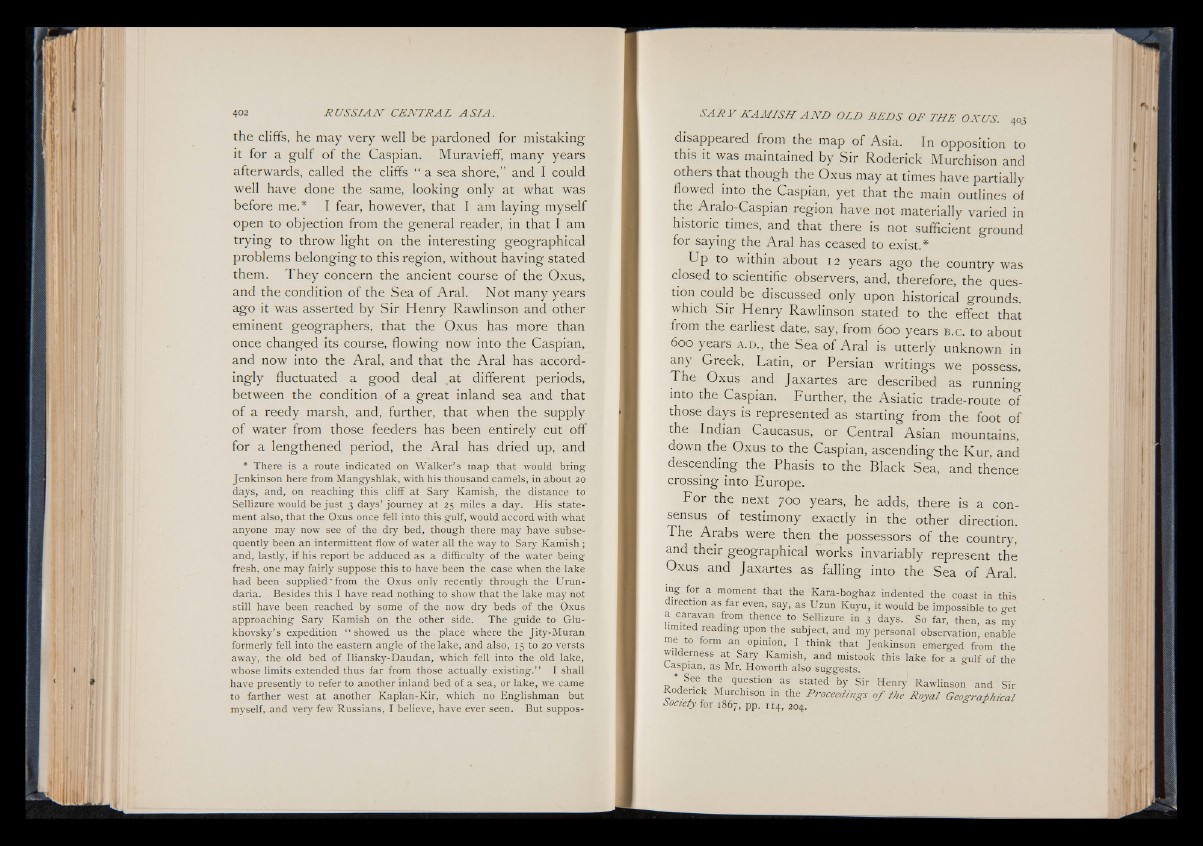
the cliffs, he may very well be pardoned for mistaking
it for a gulf of the Caspian. Muravieff many years
afterwards, called the cliffs “ a sea shore,” and I could
well have done the same, looking only at what was
before me.* I fear, however, that I am laying myself
open to objection from the general reader, in that I am
trying to throw light on the interesting geographical
problems belonging to this region, without having stated
them. They concern the ancient course of the Oxus,
and the condition of the Sea o f Aral. Not many years
ago it was asserted by Sir Henry Rawlinson and other
eminent geographers, that the Oxus has more than
once changed its course, flowing now into the Caspian,
and now into the Aral, and that the Aral has accordingly
fluctuated a good deal at different periods,
between the condition of a great inland sea and that
of a reedy marsh, and, further, that when the supply
of water from those feeders has been entirely cut off
for a lengthened period, the Aral has dried up, and
* There is a route indicated on Walker’s map that would bring'
Jenkinson here from Mangyshlak, with his thousand camels, in about 20
days, and, on reaching' this cliff at Sary Kamish, the distance to
Sellizure would be just 3 days’ journey at 25 miles a day. His statement
also, that the Oxus once fell into this gulf, would accord with what
anyone may now see of the dry bed, though there may have subsequently
been an intermittent flow of water all the way to Sary Kamish ;
and, lastly, if his report be adduced as a difficulty of the water being
fresh, one may fairly suppose this to have been the case when the lake
had been supplied' from the Oxus only recently through the Urun-
daria. Besides this I have read nothing to show that the lake may not
still have been reached by some of the now dry beds of the Oxus
approaching Sary Kamish on the other side. The guide to Glu-
khovsky’ s expedition “ showed us the place where the Jity-Muran
formerly fell into the eastern angle of the lake, and also, 15 to 20 versts
away, the old bed of Iliansky-Daudan, which fell into the old lake,
whose limits extended thus far from those actually existing.” I shall
have presently to refer to another inland bed of a sea, or lake, we came
to farther west at another Kaplan-Kir, which no Englishman but
myself, and very' few Russians, I believe, have ever seen. But supposdisappeared
from the map of Asia. In opposition to
this it was maintained by Sir Roderick Murchison and
others that though the Oxus may at times have partially
flowed into the Caspian, yet that the main outlines of
the Aralo-Caspian region have not materially varied in
historic times, and that there is not sufficient ground
for saying the Aral has ceased to exist.*
Up to within about 12 years ago the country was
closed to scientific observers, and, therefore, the question
could be discussed only upon historical grounds,
which Sir Henry Rawlinson stated to the effect that
frorrr the earliest date, say, from 600 years B.C. to about
600 years a .d ., the Sea of Aral is utterly unknown in
any Greek, Latin, or Persian writings we possess.
The Oxus and Jaxartes are described as running
into the Caspian. Further, the Asiatic trade-route of
those days is represented as starting from the foot of
the Indian Caucasus, or Central Asian mountains,
down the Oxus to the Caspian, ascending the Kur, and
descending the Phasis to the Black Sea, and thence
crossing into Europe.
For the next 700 years, he adds, there is a consensus
of testimony exactly in the other direction.
The Arabs were then the possessors of the country,
and their geographical works invariably represent the
Oxus and Jaxartes as falling into the Sea of Aral.
mg for a moment that the Kara-boghaz indented the coast in this
direction as far even, say, as Uzun Kuyu, it would be impossible to get
a caravan from thence to Sellizure in 3 days. So far, then, as my
limited reading upon the subject, and my personal observation, enable
me to form an opinion, I think that Jenkinson emerged from the
wi derness at Sary Kamish, and mistook this lake for a gulf of the
Caspian, as Mr. Howorth also suggests.
* See the question as stated by Sir Henry Rawlinson and Sir
Roderick Murchison in the Proceedings o f the Royal Geographical
¿society for 1867, pp. 114, 204.